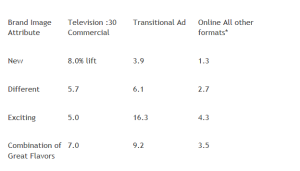Study Examined Ad Campaign Launching the McDonalds Grilled Chicken Flatbread Sandwich
New York, NY – June 3, 2003 – Today, the Interactive Advertising Bureau released new research results from McDonalds on the effectiveness of different online ad sizes in achieving marketing goals. The research, part of the ongoing Cross Media Optimization Study (XMOS), looked at the advertising campaign for the launch of McDonalds Grilled Chicken Flatbread Sandwich to determine the impact of individual ad sizes, as well as the incremental effect of each format in conjunction with and over offline (TV) advertising, in influencing McDonalds branding goals. Overwhelmingly, the research demonstrated that larger online ads perform better in communicating brand attributes.
The study, conducted by Rex Briggs, Marketing Evolution, tested the :30 television commercial along with the following online ad sizes:
Transitional ad – a large size (550 x 480) 30-second SUPERSTITIAL® ad that plays as consumers go between Web pages.
Banners – (468×60)
Skyscrapers – (160×60, 120×600 and 120×400)
Boxes – (300×250, 510×425 and 550×480)
Rectangles – (210×275 and 260×140)
The research controlled the creative elements of the ad campaign in order to measure the contribution of each ad size in affecting marketing goals. The brand attributes tested included: “New”, “Different”, “Exciting” and “Combination of Great Flavors”. Specifically, the largest “lift” in consumer awareness of each brand attribute came from use of the transitional ad. This rise was most striking in the case of “Exciting” where not only did the transitional ad outperform the other ad sizes, it outperformed TV in achieving awareness goals.
“Identifying ad size effectiveness is crucial for advertisers to effectively deploy online marketing efforts. Overall, we were pleased with the success of our on-line campaign and notably the results from the use of the Superstitial. For most advertisers, including McDonald’s, ”Exciting” is a critical attribute to move with any campaign (off-line or on-line), as it represents the emotional connection the consumer has with a brand as a result of the advertising. The transitional [Superstitial] ad unit successfully communicates the “exciting” attribute to our target. This study helps demystify the significant contribution online advertising can make in conjunction with Television, radio and print advertising,” said Neil Perry, Senior Director, Internet Marketing, McDonald’s Corporation.
The chart below represents results for all attributes tested. Percentages represent the incremental lift in consumer response (i.e. “The McDonald’s Flatbread Sandwich is ‘New’) after being exposed to the respective ad unit:

Note: All other formats include all online formats with the exception the transitional ad.
“The XMOS research has already shown us that by identifying the optimal advertising mix, advertisers can increase brand or sales impact from 7 to 34 percent,” said Greg Stuart, president and CEO, IAB. “This additional analysis here proves that communicating Brand Imagery and consumer preference, once the domain of TV, can be successfully accomplished online. In fact, it’s astonishing to see that by using online advertising, persuading consumers that a product is “exciting” can be significantly improved by over what TV alone can do – especially in the case of transitional ads.”
Twenty-one online publishers and industry leading companies funded XMOS including: 24/7 Real Media, America Online, Ask Jeeves, Classified Ventures (Cars.com), CNET Networks Inc., The Excite Network, Flipside Network, Forbes.com, iVillage Inc., Meredith Corp., MSN, New York Times Digital, RealNetworks, Terra Lycos, Unicast, Univision.com, USATODAY.com, Walt Disney Internet Group, The Wall Street Journal Online, The WashingtonPost.Newsweek Interactive, and Yahoo!.